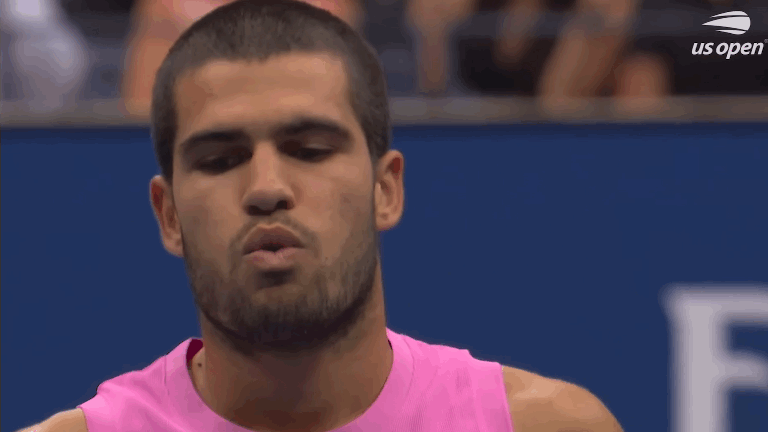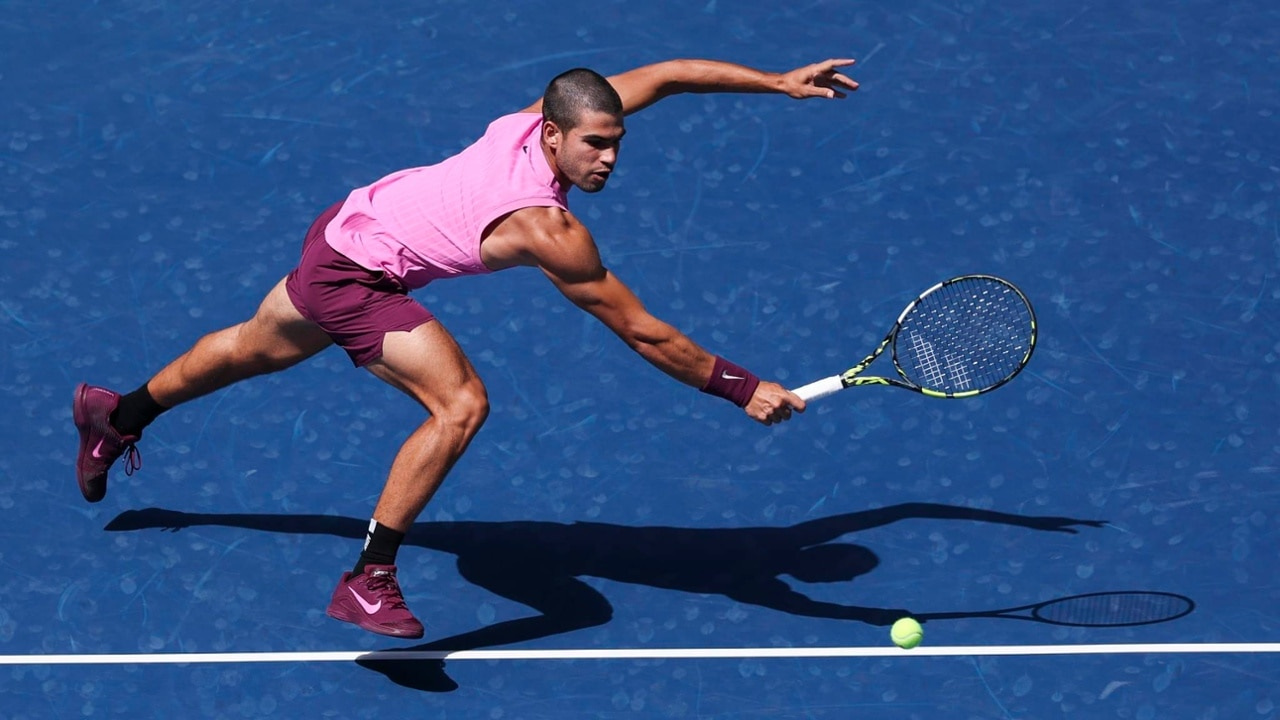Carlos Alcaraz Strikes Back
Carlitos goes God mode leaving Jannik searching for answers
Carlos Alcaraz Goes God Mode in New York
At 1-3 in the first set of the 2025 US Open final, Carlos Alcaraz hit a volley so ridiculous the New York crowd lost its mind.
It was already 0-15, Jannik Sinner serving, and Carlos pounced on a second serve. The return pulled Sinner into the doubles alley and he responded with a heavy backhand deep into Alcaraz’s backhand corner. Against most players, Sinner’s backhand would force a neutral or defensive reply. But Alcaraz had only one word in his playbook: Attack. He did one of the most difficult things in tennis, he took Sinner’s pace and redirected it, smoking the ball down the line.
The ball skidded off the sideline, sending Sinner scrambling cross court to retrieve it. Recognizing that, Carlos surged forward. He was a little late though, so before he even reached the service line, Sinner had already uncorked a forehand missile headed straight to his feet. Carlos was seemingly caught in no man’s land. Ninety-nine of a hundred players would flub the volley, or at best float it back for Sinner to crush. Alcaraz did neither. He quickly hopped aside, stabbed his racquet at the ball, and somehow feathered the supersonic forehand into the far corner of the service box as if he’d placed it by hand. Sinner took one step and then didn’t even bother.
On the broadcast, Mary Carillo gasped. The Ashe crowd erupted. Jim Courier sounded as if something broke in his brain, blurting out, “How does he do that?”
Even Alcaraz mouthed wow toward his box and smiled:
After that point, the final was basically over. Alcaraz seemed to come into the final with a game plan: attack the second serve, rip the forehand at any opportunity and don’t let up.
What made Carlos fallible in the past were the dips, his relative youth and smiling nature meant he wasn’t a cold blooded killer like Sinner, he’d play with his food a bit. He’d look for the impossible shot, trying to bring the crowd to its feet, and sometimes miss, causing him to lose to lesser opponents. But he parked the showman for the final. This was Carlos as trained assassin, walking in there with a suffocating strategy and executing it, with brilliance now a byproduct rather than the goal.
Carlos Flips The Script
Two months earlier at Wimbledon, Sinner responded to that devastating Roland Garros final loss by turning Centre Court into his laboratory, dissecting Carlos’s game with clinical precision. By the time they arrived in New York, Sinner was the slight favourite: defending champion, reigning Wimbledon winner, a showdown on his preferred surface looming. Alcaraz, despite leading the head-to-head, seemed to be chasing him.
But this was not last year’s Open, when Botic van de Zandschlup stunned Carlitos early1. Alcaraz hadn’t dropped a set before the final. The Spaniard faced just nine break points before the final, and saved seven of them. He lost three service games the whole tournament. He steamrolled Djokovic in straights in what ended up being his worst tennis of the fortnight.
In executing his Attack game plan, Alcaraz took on the features of his rival: he was clinical. Coach Juan Carlos Ferrero described it as "a perfect performance.” He wasn’t playing to put the crowd in hysterics, he was playing to dominate. And if it happened that a ‘wow’ volley materialized, it was as a result of executing planned tactics, not for the sake of the highlight reel.
After the final, Alcaraz reflected that this was the best tournament he’d played start to finish. Ferrero revealed that skipping the Canada Masters was used to study tape of the Wimbledon loss and get in the lab and work towards one goal: defeating Jannik Sinner.
Carlos showed that when he attacks with discipline, when the forehand goes nuclear and the smile is beaming, no one in the sport, Jannik Sinner included, can survive the storm.
Facing Alcaraz’s blitzkrieg, Sinner looked dazed. His game went off the rails, his serve and his forehand, usually weapons of mass destruction, went haywire. For once, the ‘AI-generated’2 player broke down.
Jannik Searching for Answers
“I was very predictable on court today. He changed up the game. That’s also his style of how he plays. Now it’s gonna be on me if I want to make changes or not. We’re definitely gonna work on that.”
- Jannik Sinner after the final
For Jannik Sinner, the final felt different from the start. The patterns he usually trusted, rushing the other player with brutal forehands and heavy backhands weren’t landing with their usual venom. Alcaraz was using his foot-speed to get there early and take away his time.
He was feeling rushed not only on the ground but on serve. Alcaraz’s blueprint of attacking the second serve was having a ripple effect on the first. His first serve percentage plummeted to 48%, giving Carlos many more opportunities to attack the second.
Between points, the frustration showed. The small shake of the head after a missed forehand, the quick glance to his box that seemed to be seeking answers. At one point, he launched a ball up to the roof of Ashe, a rare display of frustration from the cool Italian.
After the match, Jannik was unusually open and candid about making changes to his game. He talked about changing things on his serve, tweaking things to become a better tennis player3. It was startling coming from a man who up until that match was the number one player in the world for the past year.
Jannik talked about how when you win too easily you don’t try new things. He was winning with his ‘B’ game and when he was searching for his ‘A’ game, it wasn’t there. He rued the fact that he didn’t try one serve and volley the whole tournament and rarely displayed any variety in his game.
That final shook Sinner so deeply he even said he’s willing to experiment during matches, risk even losing to lesser opponents, if it means adding variety to his game and finding a way past the only one that matters: Alcaraz.
The Rivalry at a Crossroads
This God mode performance by Carlos has us thinking that he’s turned a corner in his maturation as a tennis player. He was sticking to a game plan and executing highlight reel plays all in one package. It begs the question of whether we are witnessing Carlos Alcaraz begin a new adult phase of his career, where he’s diligent about committing to deconstructing his opponents without the focus on showmanship.
Sinner’s response after the soul-crushing Roland Garros loss with a Wimbledon victory was heartening for what their rivalry can become and how the script could flip so quickly. After the Roland Garros final, he didn’t talk about changes to his game because he was right there on the precipice of victory. But at the US Open, he wasn’t close. It was a shattering experience for Jannik Sinner, a reminder that the AI generated player’s code still needs rewriting. He must adapt and re-tool or watch the tour succumb to the Alcaraz era.
Shanghai, Paris, and the ATP Finals in Turin loom, a chance for Sinner to beta test his new programming and tip the scales of the rivalry in his direction. But the way Alcaraz destroyed him might make the Wimbledon final an aberration. With all the talk of their epic encounters and taking the torch from The Big Three, this could be a one-sided rivalry; Carlos has won seven of their last eight matches.
The volley that made Carlos mouth wow could be a signal of what’s to come, a 22 year old realizing the breadth and scope of his talents in real time. Or Sinner could add a new functionality in their next match up that forces Alcaraz back to the lab. What’s scarier for Sinner and the rest of the tour is this: if Alcaraz is surprising himself now, discovering new strokes of genius on the fly, what happens when he can summon them at will?
Alcaraz was still feeling the hangover effects of his stunning gold medal loss in Paris to some guy named Novak.
Bublik coined him an AI generated player before the quarterfinals and then commented under a US Open Instagram post: ‘AI’ after he got doused 6-1, 6-1, 6-1.
His full quote: “Sometimes adding just something—and I think that's going to make a difference from my personal point of view, that I can say that I'm going to become a better tennis player. I'm going to change a couple of things on the serve, just small things, but you know, they can make big differences.
One thing is when the scoreline, you know, matches before are comfortable, but you always do the same things. For example, during this tournament, I didn't make one serve-volley, didn't use a lot of drop shots, and then you arrive to a point where you play against Carlos where you have to go out of the comfort zone.
So I'm going to aim to, you know, maybe even losing some matches from now on, but trying to do some changes, trying to be a bit more unpredictable as a player, because I think that's what I have to do, trying to become a better tennis player”






